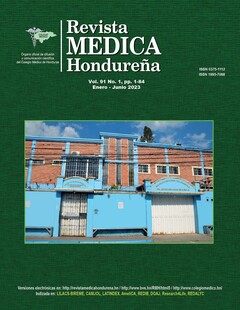Factors associated with drug-resistant epilepsy in children treated at a national referral hospital
DOI:
https://doi.org/10.5377/rmh.v91i1.16332Keywords:
Drug-resistance, Electroencephalography, EpilepsyAbstract
Background: According to the World Health Organization (WHO) about 70 million people worldwide suffer from epilepsy. Middle and low-income countries have 70-80% of cases; it is estimated that it affects 4-13% of children up to 16 years of age, of which drug-resistant epilepsy (DRE) develops in 10-23%. Objective: To determine risk factors associated with DRE in pediatric patients attended at Hospital Maria, Pediatric Specialties (HMEP), Tegucigalpa, March 2017-March 2022. Methods: Case-control study. From the total number of patients under 18 years of age with a diagnosis of epilepsy attended at the HMEP Neurology Service, Case was defined as patients with a diagnosis of DRE and Controls as patients with non-drug resistant epilepsy (NDRE). Based on clinical records, sociodemographic factors, personal and family history, clinical factors, imaging studies and electroencephalogram were evaluated. The study was approved by the Institutional Ethics Committee. Results: 81 cases and 162 controls were analyzed. The most affected age in cases was preschool (35.8%), in controls it was school age (41.4%). Male sex presented similar distribution in both groups (51.8% and 51.2%). Rural origin was more frequent in cases than in controls (58.0% versus 48.8%). The following factors associated with DRE were identified: family history of epilepsy (ORa 2.32, IC95%1.22–4.41, p=0.01), focal alteration in physical examination (ORa 2.23, IC95%1.10–4.55, p=0.02), abnormal neurodevelopment (ORa 2.78, IC95%1.18–6.54, p=0.02). Discussion: Adequate seizure control has a direct impact on the quality of life and survival of patients. The correct identification of children with epilepsy with the associated factors identified in this study, which coincide with those described internationally, will allow better screening and prioritization of early referral to a pediatric neurologist, contributing to improve the quality of life of patients.
Downloads
506
Downloads
Published
How to Cite
Issue
Section
License
Copyright (c) 2023 Autor(es)

This work is licensed under a Creative Commons Attribution 4.0 International License.




